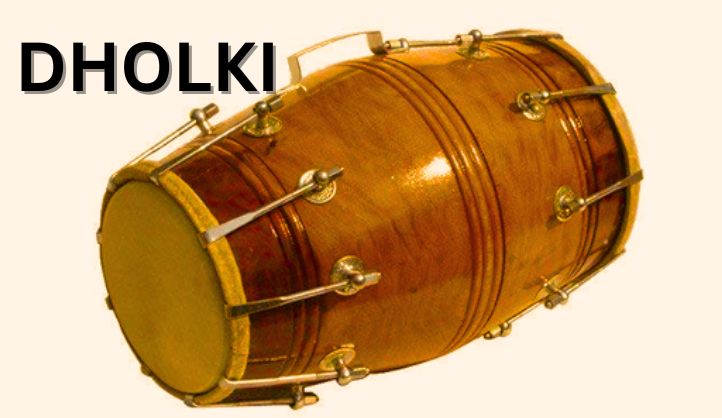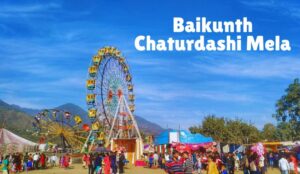Nestled in the majestic hills of Uttarakhand, the Dholki is more than just an instrument; it is the soul of the state’s rich cultural heritage. This traditional percussion instrument, often overshadowed by its more famous cousins like the tabla and dhol, plays a pivotal role in the musical landscape of Uttarakhand. Let’s dive into the captivating world of the Dholki and explore its significance, history, and the magic it brings to the vibrant culture of this Himalayan region.
The Instrument
The Dholki, a smaller variant of the dhol, is a double-headed drum with a cylindrical body, traditionally made of wood or metal. Its heads are made of animal hide, tightened with ropes or bolts to adjust the pitch. The two sides of the Dholki produce different tones: the larger head emits a deep bass sound, while the smaller head offers a sharp, high-pitched tone. This combination creates a rich tapestry of rhythms that can be both exhilarating and soothing.
Historical Roots
The origins of the Dholki are deeply rooted in the folk traditions of North India. In Uttarakhand, it has been an integral part of cultural and religious celebrations for centuries. The instrument is often linked with local deities and rituals, symbolizing a divine connection that transcends generations. The Dholki’s beats have been the backdrop to countless folk tales, dances, and festivals, making it a vital part of the region’s intangible cultural heritage.
Cultural Significance
Festivals and Celebrations
In Uttarakhand, the Dholki is indispensable during festivals like Makar Sankranti, Holi, and Diwali. Its rhythms guide the feet of dancers and uplift the spirits of the community. During weddings, Dholki’s beats are synonymous with joy and festivity, leading the processions and ensuring that every celebration is filled with music and dance.
Folk Dances
It is the heartbeat of various traditional dances like the Chholiya, Jhora, and Bhotiya. Each dance has its unique rhythm patterns, and the Dholki players, with their intricate knowledge, create an immersive experience that captivates audiences. The Chholiya dance, in particular, is a martial dance form where the robust beats of the Dholki complement the vigorous movements of the dancers.
Spiritual and Religious Practices
The Dholki’s presence is not limited to entertainment; it also holds spiritual significance. During religious ceremonies and rituals, its beats are believed to purify the environment and invoke blessings from the deities. In temples and during community prayers, the Dholki’s rhythms create an atmosphere of devotion and reverence.
The Art of Playing
Mastering the Dholki requires not just skill but also a deep understanding of its cultural context. Traditionally, the art of playing the Dholki is passed down through generations, with techniques and rhythms being taught orally. A proficient player can evoke a wide range of emotions, from the exuberance of a festival to the solemnity of a ritual.
Other Traditional Instruments of Uttarakhand
Uttarakhand, with its rich cultural diversity and heritage, boasts several traditional instruments that reflect the region’s vibrant cultural identity.
1. Dhol
The Dhol is a large, double-headed drum played with sticks. It produces a deep, resonant sound and is often used in festivals, weddings, and folk dances. The Dhol’s powerful beats are essential in creating the dynamic energy of performances like the Chholiya dance.
2. Damau
The Damau is a smaller, kettle-shaped drum paired with the Dhol. It produces a higher-pitched tone and complements the Dhol’s bass sounds. The interplay between the Dhol and Damau creates a rich rhythmic tapestry that is characteristic of Uttarakhand’s traditional music.
3. Turri
The Turri is a wind instrument made from a large conch shell. It produces a loud, penetrating sound and is typically used in religious ceremonies and rituals. The Turri’s sound is believed to purify the environment and ward off evil spirits.
4. Ransingha
The Ransingha, also known as the Narasingha, is a traditional brass or copper horn. Shaped like an S or a crescent, it is often used in ceremonial and festive occasions. The Ransingha’s bold and brassy tones are used to announce significant events and gatherings.
5. Bhurang
The Bhurang is a type of plucked string instrument, similar to a zither. It has a flat body with strings stretched across it, producing a soft and melodic sound. The Bhurang is often used in accompaniment to vocal performances, adding a gentle harmonic backdrop.
6. Mashakbeen
The Mashakbeen, also known as the Bagpipe of Uttarakhand, is a unique wind instrument similar to the Scottish bagpipe. It has a bag made from animal hide and several pipes for producing sound. The Mashakbeen is used in various folk performances and is cherished for its distinctive, droning sound.
7. Hurka
The Hurka is a small hand drum with a wooden frame and a single drumhead. It is often played during storytelling sessions and folk performances. The Hurka’s light, rhythmic beats help set the pace for narratives and dances.
Preserving the Tradition
In an era where modern music often overshadows traditional forms, preserving the art of this instrument is crucial. Efforts are being made by cultural organizations and local communities in Uttarakhand to keep this tradition alive. Workshops, cultural festivals, and educational programs are being organized to teach the younger generation about the Dholki and its significance.
Conclusion
The Dholki is more than just an instrument; it is a testament to Uttarakhand’s rich cultural tapestry. Its beats resonate with the history, traditions, and spirit of the people. As we embrace the future, it is essential to honor and preserve such cultural treasures, ensuring that the rhythmic heartbeat of the Dholki continues to echo through the hills of Uttarakhand for generations to come.
Whether you find yourself amidst the vibrant festivals or the tranquil temples of Uttarakhand, listen closely. The Dholki’s rhythm will guide you to the heart of this enchanting region, offering a glimpse into its soul through the timeless language of music.
FAQs About Dholki Traditional Instrument Of Uttarakhand
1. What is a Dholki?
It is a traditional double-headed drum, similar to a small dhol, commonly used in the folk music of Uttarakhand. It has a cylindrical body, usually made of wood or metal, and two heads made of animal hide that produce different tones when struck.
2. What is the cultural significance of the Dholki in Uttarakhand?
It is deeply embedded in the cultural and religious fabric of Uttarakhand. It is a central element in festivals, weddings, folk dances, and religious ceremonies, symbolizing joy, celebration, and spiritual connection.
3. What are some traditional dances that feature the Dholki?
Traditional dances such as Chholiya, Jhora, and Bhotiya prominently feature the Dholki. Each dance has unique rhythms and movements that are enhanced by the beats of the Dholki.
4. How is the Dholki played?
It played with my hands. The player uses different techniques to strike the drumheads, creating a variety of rhythms and tones. The larger drumhead produces a deep bass sound, while the smaller drumhead offers a sharp, high-pitched tone.
5. Who typically plays the Dholki in Uttarakhand?
Traditionally, the art of playing the Dholki is passed down through generations within families or communities. However, anyone with an interest in Uttarakhand’s folk music can learn to play the Dholki through practice and guidance from experienced players.





